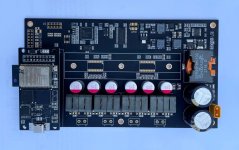At one point, in a conversation, my good acquaintance mentioned that analog input and output are almost vestiges in the modern world of storing information in digital form. Class D amplifiers allow the creation of a powerful PWM DAC that outputs an already amplified signal, thus eliminating all the problems inherent in weak analog signal paths. Since then, this idea has been implemented in circuit solutions, and eventually, I came to the construction of active speakers with a digital input based on the ADAU1452 DSP. The simplicity of configuring active speakers using the capabilities of Sigma Studio and ADAU1452 amazed me. When I tried to convince others that configuring a digital active speaker with DSP is very simple, they always pointed to the cost of factory-made solutions.
I decided that my version of active speakers might appeal to people who want to enter the digital active speaker domain but are deterred by the price of mass-produced items. In this thread, I would like to discuss with such individuals their preferences for such a solution. I am currently creating a prototype module for active speakers in which I can make changes according to the wishes of people who want to create their own three-way active speakers without analog input. In this thread, I want to understand how many people are willing to give up analog input in favor of digital and what they need for this.
The main question of the thread is - if you have a desire to build a three-way active stereo speaker, and if this speaker does not have an analog input, what would stop you, and conversely, what would encourage you to give up analog input?
Below is the block diagram of one module for a three-way active speaker.
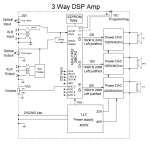
At this stage of module development, it includes an optical S/PDIF input and AES/EBU. It also allows the transit of S/PDIF streams through both optical and AES/EBU inputs. There is the option to route the S/PDIF stream through the DSP processor. The diagram should make clear the available options. Using an auxiliary ADC input, there is the ability to adjust the sound level with an external potentiometer.
The question is - in your opinion, what is missing on this board, and does it make sense to reconsider the relevance of certain digital inputs?
I decided that my version of active speakers might appeal to people who want to enter the digital active speaker domain but are deterred by the price of mass-produced items. In this thread, I would like to discuss with such individuals their preferences for such a solution. I am currently creating a prototype module for active speakers in which I can make changes according to the wishes of people who want to create their own three-way active speakers without analog input. In this thread, I want to understand how many people are willing to give up analog input in favor of digital and what they need for this.
The main question of the thread is - if you have a desire to build a three-way active stereo speaker, and if this speaker does not have an analog input, what would stop you, and conversely, what would encourage you to give up analog input?
Below is the block diagram of one module for a three-way active speaker.

At this stage of module development, it includes an optical S/PDIF input and AES/EBU. It also allows the transit of S/PDIF streams through both optical and AES/EBU inputs. There is the option to route the S/PDIF stream through the DSP processor. The diagram should make clear the available options. Using an auxiliary ADC input, there is the ability to adjust the sound level with an external potentiometer.
The question is - in your opinion, what is missing on this board, and does it make sense to reconsider the relevance of certain digital inputs?
Last edited:
Since ADAU has an I2S input, I decided to try implementing wireless music streaming via Wi-Fi, Bluetooth AptX HD, and as a bonus, via USB, using an ESP32 module and open-source software for these modules. These modules will be in my hands shortly, and I will start experiments. However, wireless data transmission raises the question of volume control in the speakers. It's not entirely clear where volume control can be organized more optimally.I'd like to connect wirelessly via lossless digital.
I also want to try giving up the wired programmer for ADAU1452, i.e., controlling ADAU via Wi-Fi as a network device. But all of this needs to be tested in hardware, and there is a lot of new information to process.
As one of the possible options, yes, it's possible to use the internal volume control in ADAU. I don't see any issues with that. Below are measurements I just took by applying a 0dB(Fs) input to ADAU and reducing the amplifier's output volume to -10dB and -20dB using ADAU. I don't see any issues in the measurements.You will control the output amplitude (volume) in digital domain inside ADAU? This does not give good THD, especially below -10-20 dB.
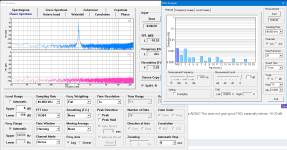
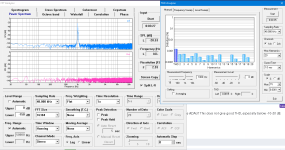
I obtained the following results.What output performance do you expect with PWM Power DAC?
This is for a 200W DAC. 0dB equals 200W at 4 ohms.
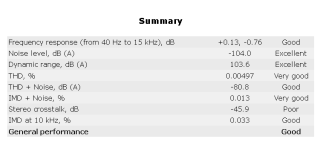
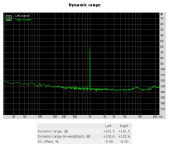
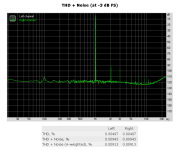
And this is for a 100W DAC, where 0dB corresponds to 100W at 4 ohms
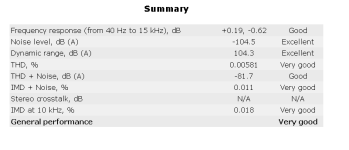
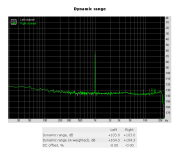
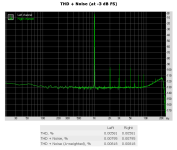
This PWM DAC has programmable hardware components to correct the amplified PWM signal, and there is no feedback based on the output analog signal in this PWM DAC. The output low-pass filter of the PWM DAC is not subject to feedback, leading to distortion in the frequency response in the high-frequency range. However, since this DAC operates in conjunction with a DSP, the distortion in the frequency response is not a problem, as the output frequency response will be adjusted using an equalizer in the DSP based on measurements of the frequency response of the speaker connected to the output of this DAC.If your PWM power DAC is working open loop rather than with feedback from the analogue output, you must have made a really good power supply!
This is for a 200W DAC. 0dB equals 200W at 4 ohms.
Try to measure at 1-5W, which is real power at home.
(Of сourse if you speakers are not Ссы90, with 82dB/1W/1m).
Below are measurements I just took by applying a 0dB(Fs) input to ADAU and reducing the amplifier's output volume to -10dB and -20dB using ADAU. I don't see any issues in the measurements.
Where did you measure this? At amplifier's (PowerDAC) output?
According toy YOUR measurements, you PowerDAC have THD+N=-80dB - this means 13 bit.
-24dB digital volume means 4bit lost
-42dB t- means 7 bit lost...
Alex.
This PWM DAC has programmable hardware components to correct the amplified PWM signal, and there is no feedback based on the output analog signal in this PWM DAC.
Also no feedback from the unfiltered PWM signal?
What I meant is nonlinear distortion. You manage to keep the harmonic distortion low and the noise floor reasonably low, even though you use the power supply as the DAC reference, if it is really working open loop. That means you must have an exceptionally good power supply - unless the "programmable hardware components", whatever they may be, reduce the power supply requirements somehow.
According toy YOUR measurements, you PowerDAC have THD+N=-80dB - this means 13 bit.
-24dB digital volume means 4bit lost
-42dB t- means 7 bit lost...
Alex.
Not really, the noise floor is -104 dB(A) or -104.5 dB(A) with respect to maximum power.
A careful person who understands why they need such power in each band will not apply such a solution to high-sensitivity speakers, as it will result in at least audible white noise at the speaker's output. This amplifier is intended for speakers with low sensitivityTry to measure at 1-5W, which is real power at home.
(Of сourse if you speakers are not Ссы90, with 82dB/1W/1m).
Yes, at the output of the DAC loaded with a 4-ohm load.Where did you measure this? At amplifier's (PowerDAC) output?
I understand that the translator provided a somewhat unclear translation. In this DAC, there is feedback for pulse-width modulation (PWM). The low-pass filter (LPF) is not covered by feedback.Also no feedback from the unfiltered PWM signal?
Agreed, one should base considerations on the noise floor rather than THD+N.Not really, the noise floor is -104 dB(A) or -104.5 dB(A) with respect to maximum power.
THD or SNR? Digital attenuation will limit your SNR but THD will generally increase with output level, particularly on DACs approaching FS, so distortion should be reduced by digital attenuation. If you're listening to post-Rick Rubin popular music, you're likely in intersample over territory on 0dB peaks, so if your DAC doesn't do well on those then digital attenuation will get rid of unpleasant artifacts--i.e. the distortion reduction by digital attenuation will be even greater than the datasheet indicates.You will control the output amplitude (volume) in digital domain inside ADAU? This does not give good THD, especially below -10-20 dB.
What output performance do you expect with PWM Power DAC?
Alex.
I also want to try giving up the wired programmer for ADAU1452, i.e., controlling ADAU via Wi-Fi as a network device. But all of this needs to be tested in hardware, and there is a lot of new information to process.
https://www.diyaudio.com/community/...-p-dif-adat-bluetooth-and-wifi-contro.334055/
I implemented such modules in Amanero format and used it with similiar design: TAS5548 + 4 PWM drivers + ADAU1452:Since ADAU has an I2S input, I decided to try implementing wireless music streaming via Wi-Fi, Bluetooth AptX HD, and as a bonus, via USB, using an ESP32 module and open-source software for these modules. These modules will be in my hands shortly, and I will start experiments. However, wireless data transmission raises the question of volume control in the speakers. It's not entirely clear where volume control can be organized more optimally.
I also want to try giving up the wired programmer for ADAU1452, i.e., controlling ADAU via Wi-Fi as a network device. But all of this needs to be tested in hardware, and there is a lot of new information to process.
https://www.diyaudio.com/community/threads/audio-transport-module-york.406025/
It is a working solution, however if you plan to use SigmaTCP (SigmaStudio TCPIP) protocol - it only works for loading the data into ADAU and change controls in the design, reading from the DSP does not work because of issues in SigmaStudio (known for years and yet not fixed by ADI).
ESP32 is quite okay with things like AirPlay, Spotify, however there is still no really robust and stable firmware. That's the main reason why I still didn't fully released the module.
Regarding volume control: I tried power supply volume control - there is a DC-DC on the board. However, it can cover only few dB of the range, so not sure if it really worth it for this purpose
Attachments
This is for analog signal, but for the D/A conversion, THD decreased with digital attenuation because less bits are working.THD will generally increase with output level, particularly on DACs approaching FS, so distortion should be reduced by digital attenuation.
Alex.
Where do you think these bits are lost? At the DAC output, or at the DAC input?According toy YOUR measurements, you PowerDAC have THD+N=-80dB - this means 13 bit.
-24dB digital volume means 4bit lost
-42dB t- means 7 bit lost...
Inside 
Digital volume control, is Dout = Din/Vol.
Every 6 dB is equivalent to 1 bit less (shift right), so the result depends on what is left and how many real bits (ENOB) the DAC had initially.
For a DAC with ENOB 20-21 bits (AKM4497/99, ESS9038/39, etc.), the loss of 4-7 bits is not the same as the loss for a DAC with real 13-15 bits.
Alex.
Digital volume control, is Dout = Din/Vol.
Every 6 dB is equivalent to 1 bit less (shift right), so the result depends on what is left and how many real bits (ENOB) the DAC had initially.
For a DAC with ENOB 20-21 bits (AKM4497/99, ESS9038/39, etc.), the loss of 4-7 bits is not the same as the loss for a DAC with real 13-15 bits.
Alex.
Are you saying that ENOB PWM DAC calculated by THD+N will decrease by 4 bits when the volume is reduced by 4 bits?For a DAC with ENOB 20-21 bits (AKM4497/99, ESS9038/39, etc.), the loss of 4-7 bits is not the same as the loss for a DAC with real 13-15 bits.
ENOB is calculated at 0 dBFs.
Well, okay, do you think that at the output of the DAC that I implemented, its resolution (bit depth) will decrease in proportion to the decrease in bit depth during digital volume control?
Last edited:
- Home
- Source & Line
- Digital Line Level
- Three-way powerful PWM DAC with DSP ADAU1452, for implementation active speakers
